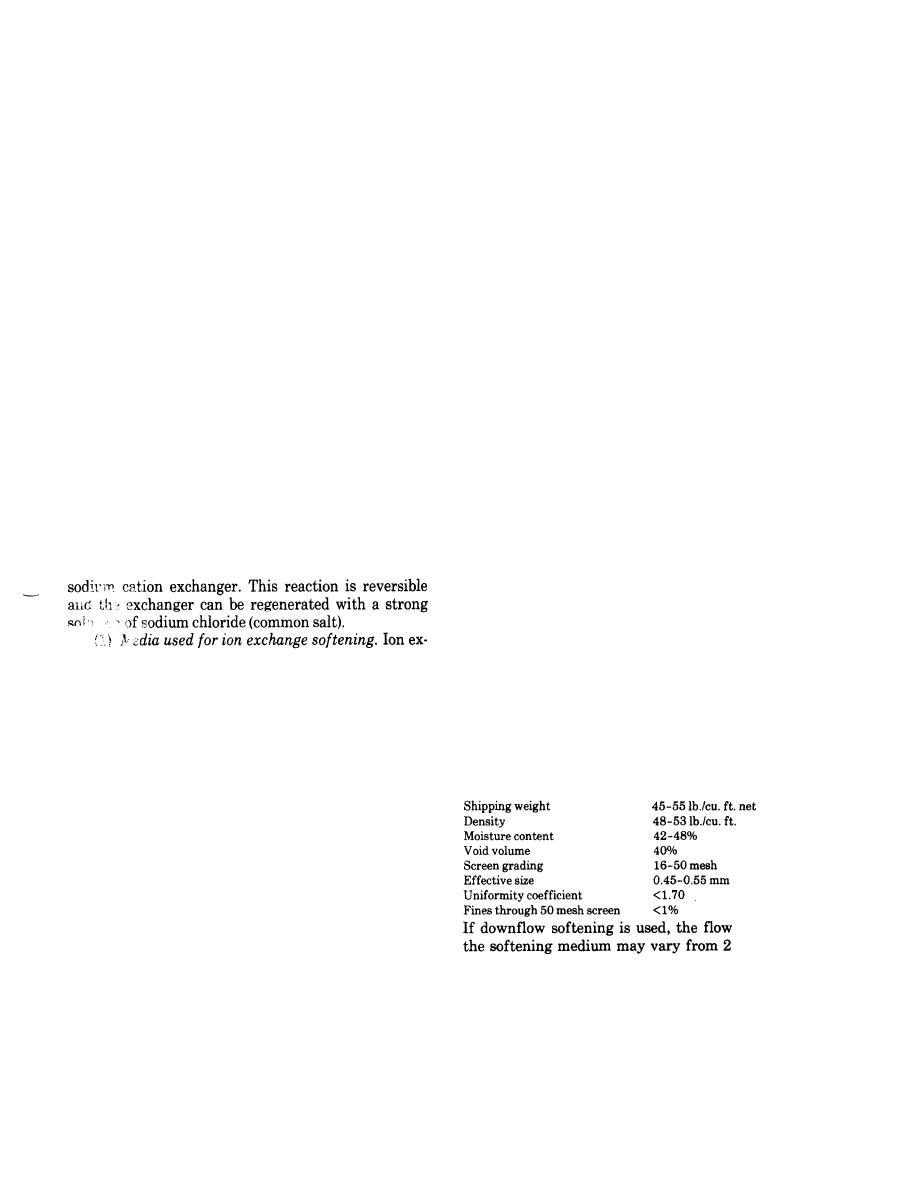
TM 5-813-3/AFM 88-10, Voi 3
flow 3 to 5 times as great as the rate of flow through
Regeneration brines should be 10 to 15 percent solu-
the entire unit. The upflow rate at the slurry separa-
tions of salt. The more salt used in the regeneration of
tion level in the clarification zone should not exceed
a softener, the more complete the regeneration will be,
approximately 1.5 gpm per square foot.
and the greater the exchange capacity of the regen-
(e) Chemical application and storage. Lime feed-
erated medium will be. The costs of the extra salt re-
ers and slakers are key items of equipment at a soften-
quired to obtain the added exchange capacity must be
ing plant and must be selected on the basis of reliabil-
weighed against the advantages of the higher ex-
ity. Another important item requiring careful consid-
change capacity in order to determine which salt dos-
eration by the designer is chemical storage. Depending
age to use. Salt consumption commonly ranges from
on the size of the plant, bulk or bag unloading and stor-
about 0.3- to 0.5-pound of salt per 1,000 grains of
age for lime and soda ash must be provided. Storage
hardness removed. The contact time of the brine with
equivalent to at least 30 days average use shall be pro-
the softening medium also has a direct effect on the
vided. Caustic soda, if used, will generally be pur-
exchange capacity of the regenerated medium. Con-
chased as a 50 percent solution and appropriately sized
tact times of 20 to 35 minutes will generally be used.
(c) Rinsing. After regeneration, the brine must
storage tanks must be provided for this chemical.
be rinsed from the unit before softening is resumed.
(f) Sludge disposal. A disadvantage of any lime
softening process is the production of a large mass of
Disposal of backwash water, spent regenerant, and
sludge of high water content. Provision for its disposal
rinse water must be carefully considered.
(3) Ion exchange water softeners. Although most
in an environmentally acceptable manner must be
made and this problem must be carefully considered in
ion exchange softeners at military installations will be
connection with softening plant location and design.
downflow pressure softeners, softening can also be
c. Cation exchange softening. Hardness is caused
achieved upflow. Larger ion exchange softening facili-
principally by the cations calcium and magnesium, and
ties are often operated upflow in order to avoid the ne-
cation exchange softening is accomplished by exchang-
cessity of backwashing. In general, ion exchange soft-
ing these ions for a cation, usually sodium, which does
eners are of two types; open gravity softeners and
not contribute to hardness. This exchange is achieved
pressure softeners.
(a) Open gravity softeners. Open gravity soften-
by passage of the water through the bed of a granular
ers are constructed in much the same manner as rapid
sand filters, and the modes of operation are very simi-
lar. However, the ion exchange medium used in open
gravity softeners is much lighter than the sand used in
filters, so backwash rates for open gravity softeners
change water softeners at fixed military installation
shall use polystyrene resins as the softening media.
may also be operated upflow, but the softener will not
Such resins must have a hardness exchange capacity of
achieve any filtering effects so the influent water must
at least 25,000 grains of hardness per cubic foot of res-
be virtually free of suspended matter.
in.
(b) Pressure softeners. A polystyrene resin me-
(2) Regeneration of ion exchange softeners. The
dium used for pressure softening shall have a mini-
mum bed depth of 24 inches and physical properties
regeneration process generally involves three steps: (1)
approximately the same as the following:
backwashing, (2) application of regeneration solutions,
and (3) rinsing.
(a) Back washing. The purposes of water soften-
er backwashing are generally the same as the purposes
of filter backwashing. Any turbidity particles filtered
out of the water during softening are removed by the
backwashing process. For polystyrene resin media, bed
expansions of from 50 to 100 percent are normally re-
rate through
quired, which involves backflow rates of 4 to 10 gal-
to 8 gpm per
lons per minute per square foot of bed area. Backwash
periods generally range from 2 to 5 minutes. Ion ex-
square foot but must not exceed 10 gpm per square
foot under the most severe loadings. Severe reductions
change water softeners which operate upflow rather
than downflow will not require backwashing, but the
in exchange capacity are experienced if the softener
water to be softened must be virtually free of suspend-
operates at rates of flow in excess of 10 gpm per cubic
foot for sustained periods of time. With upflow soften-
ed matter.
(b) Application of salt brine. After the unit has
ing, the rate of flow should be adjusted to maintain a
been backwashes, a salt solution is applied to the me-
bed expansion of from 40 to 60 percent. The degree of
bed expansion is a function of both the flow rate and
dium in order to regenerate its softening capabilities.
2-23


 Previous Page
Previous Page
